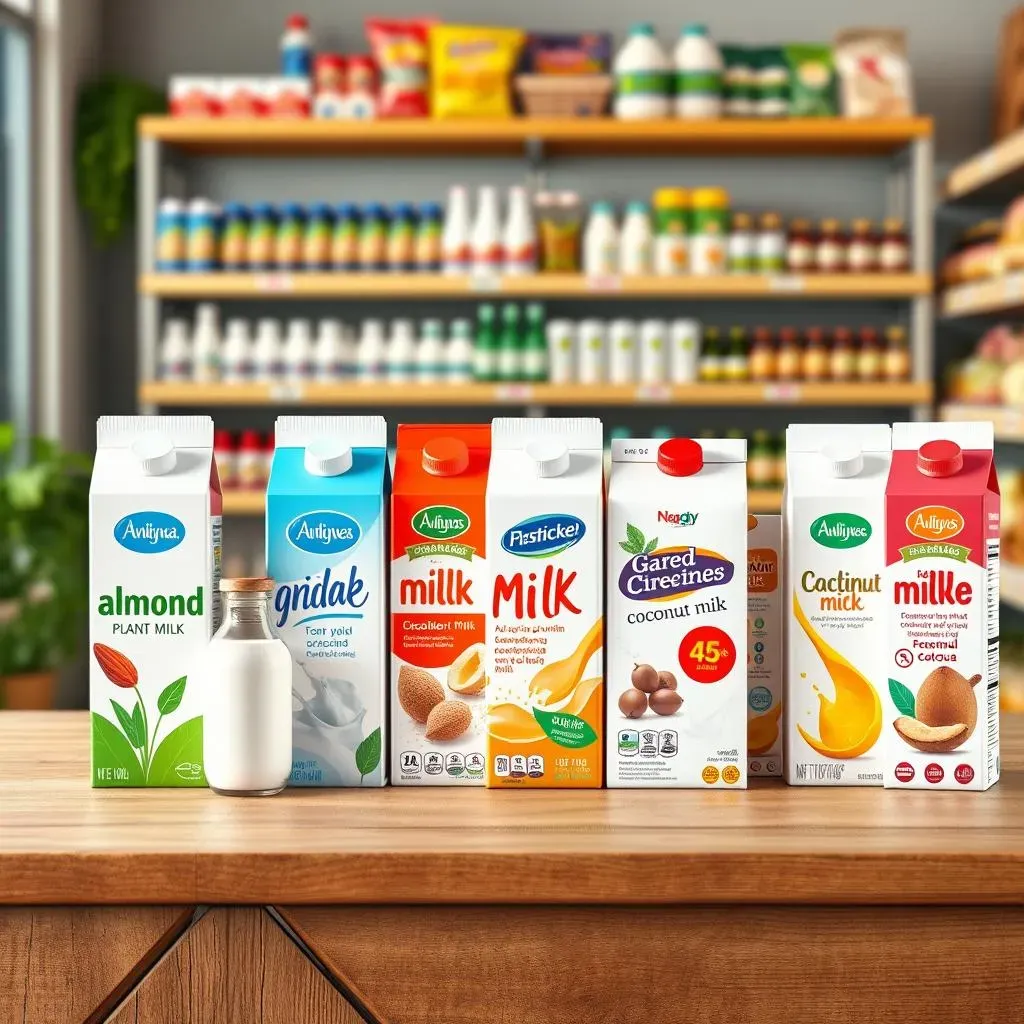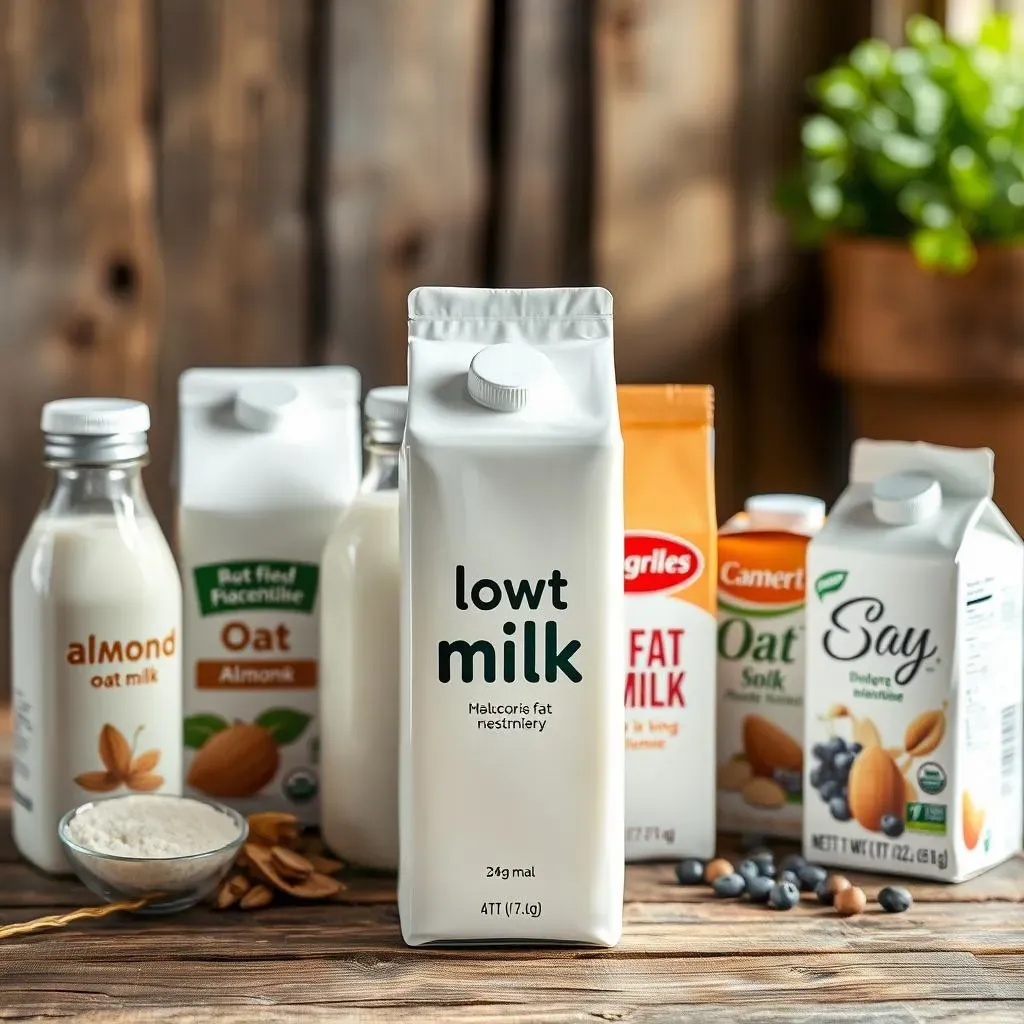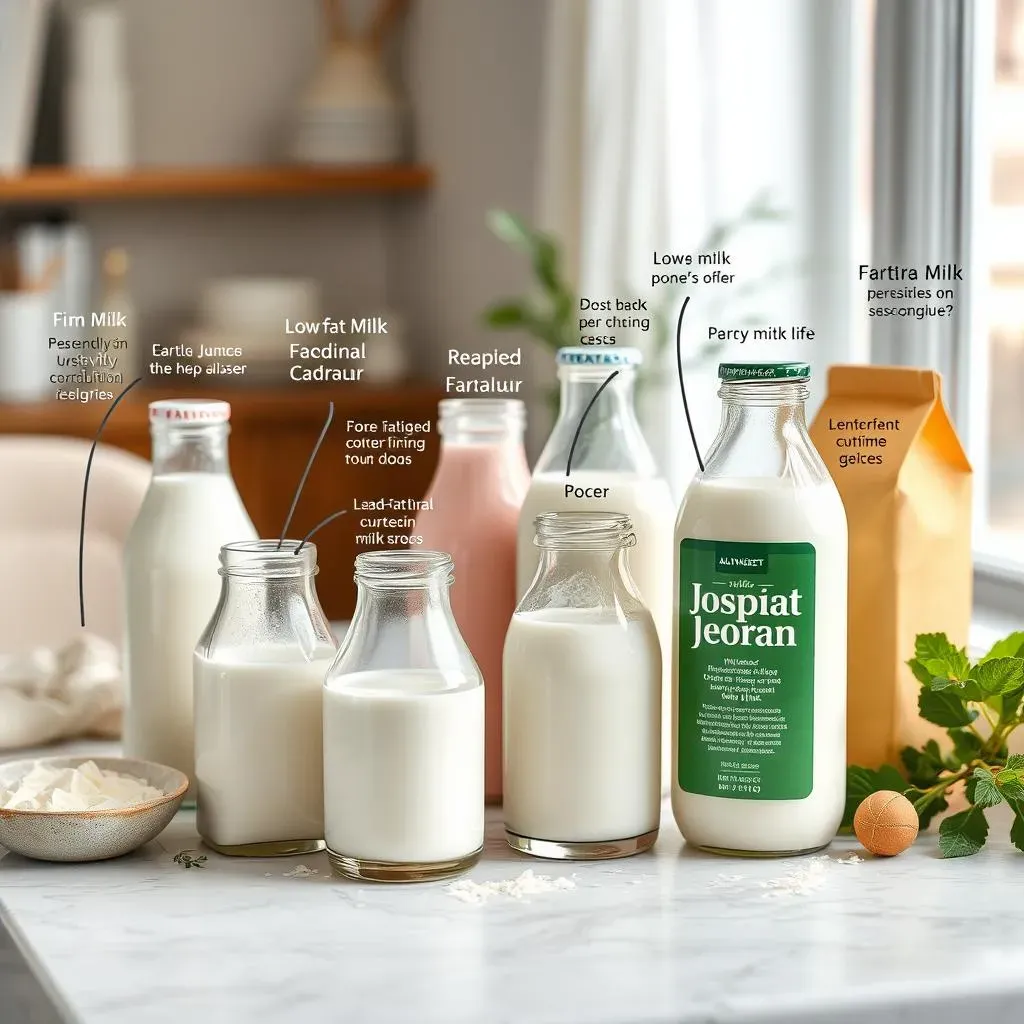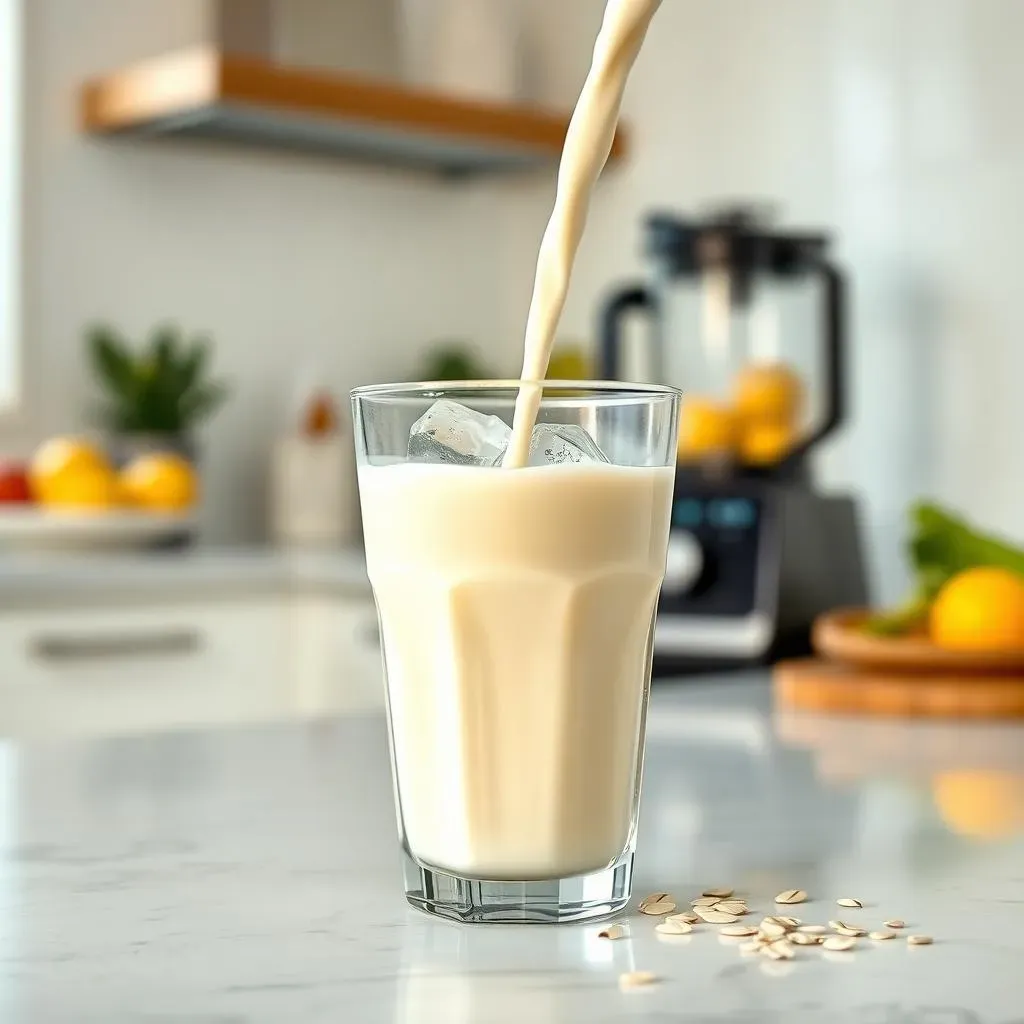Table of Contents
Are you looking to cut back on dairy or just want a change? Maybe you're trying to find a good low fat milk substitute that doesn't taste like cardboard. Well, you're not alone! Navigating the world of milk alternatives can feel like a trip to a land of endless choices, from almond to oat, soy to coconut. It's easy to get lost in the options, especially when you're trying to keep things light and healthy. This article is your guide through this confusing landscape. We'll explore the best dairy-free low-fat substitutes, giving you the lowdown on how to make your own at home. We'll also show you what to look for when buying them at the store. We'll even share some tips to make sure you pick the right one for your needs. So, whether you're baking, cooking, or just pouring a glass, let's find the perfect low fat milk substitute for you.
DairyFree Low Fat Milk Substitutes: A World of Options

DairyFree Low Fat Milk Substitutes: A World of Options
The Big Names in Dairy-Free
Okay, so you're ditching dairy, or at least cutting back. That doesn't mean you're stuck with just water! There’s a whole universe of plant-based milks out there, each with its own personality. We've got the usual suspects: almond milk, which is pretty mild and low in calories; soy milk, the protein powerhouse; and oat milk, known for its creamy texture. Then, there's the slightly more adventurous stuff like rice milk, which is super light, and coconut milk, which brings a touch of the tropics. Each one has its own thing, and what's "best" really depends on what you're making and what your taste buds are feeling.
It's not a one-size-fits-all situation, trust me. I once tried to make a béchamel sauce with rice milk, and let’s just say it was a watery disaster. Live and learn, right? But that same rice milk is great in smoothies, so it’s not like it’s useless. It’s all about finding the right milk for the right job, and that’s part of the fun – or the frustration, depending on your perspective.
The best part is that most of these are naturally low in fat, especially the unsweetened versions. They are also often fortified with calcium and vitamin D, which is great news for those of us trying to stay healthy. Just remember to read those labels, okay? Some brands sneak in extra sugar, and nobody wants that.
A Quick Comparison
Milk Type | Flavor Profile | Best Uses | Good For |
|---|---|---|---|
Almond Milk | Mild, slightly nutty | Smoothies, cereal, baking | Low calorie |
Soy Milk | Slightly beany, creamy | Coffee, cooking, protein shakes | High protein |
Oat Milk | Naturally sweet, creamy | Lattes, baking, general use | Creamy texture |
Rice Milk | Light, slightly sweet | Smoothies, light dishes | Very light |
Coconut Milk | Distinct coconut flavor | Curries, desserts, some drinks | Rich flavor |
Beyond the Basics
Don't think the list stops there though. There are other less common, but equally awesome options. Think hemp milk, which has a slightly earthy taste, or flax milk, which is mild and a good source of omega-3s. These are often overlooked, but they can be great if you're looking for something a bit different or have specific dietary needs. The cool thing about all these plant-based milks is that they are always innovating, and new stuff is always coming out.
I remember when I first started experimenting with these alternatives, it felt like I was unlocking secret codes to a whole new world of cooking. Now, I can’t imagine going back to just regular old dairy. The variety is too good, and they're better for the environment too, which is a nice bonus.
So, don’t be afraid to try them all! Grab a few different cartons at the store and do some taste tests. You might be surprised at what you discover, and you might just find your new favorite low-fat, dairy-free milk along the way.
Making Your Own Low Fat Milk Substitute at Home

Making Your Own Low Fat Milk Substitute at Home
The DIY Route: Why Bother?
Okay, so you're thinking, "Why would I make my own milk when I can just grab a carton at the store?" Good question! Making your own low fat milk substitute at home is actually easier than you might think, and it gives you total control over what goes into it. No weird additives, no sneaky sugars, just pure, wholesome goodness. Plus, it's a pretty cool skill to have. It’s like being a kitchen wizard, turning simple ingredients into creamy, delicious milk. And let me tell you, there's something super satisfying about drinking something you made yourself. I started making my own almond milk when I was tired of the store-bought stuff having a weird aftertaste, and now, I can’t go back. It's fresher, tastier, and I know exactly what's in it.
It's also a great way to save money, especially if you're going through a lot of milk. Buying nuts and seeds in bulk and making your own milk can be way cheaper than buying cartons every week. It’s like having a mini-milk factory in your kitchen! Plus, you can get creative with flavors and textures, making it exactly how you like it. Want it thicker? Add more nuts. Want it sweeter? Throw in some dates. The possibilities are endless!
Simple Recipes for Homemade Milk
Alright, let's get down to business. Making your own low fat milk substitute is not rocket science. For almond milk, all you need is almonds, water, and a blender. Soak the almonds overnight, blend them with fresh water, and then strain the mixture through a cheesecloth or nut milk bag. Boom! You’ve got almond milk. For oat milk, it’s even easier. Blend oats with water, strain, and you’re done. No soaking required. It’s like magic, but with oats. And if you’re feeling adventurous, you can try making hemp milk or flax milk using similar methods. It’s all about experimenting and seeing what you like best.
Milk Type | Ingredients | Instructions |
|---|---|---|
Almond Milk | 1 cup almonds, 4 cups water | Soak almonds overnight, blend, strain |
Oat Milk | 1 cup oats, 4 cups water | Blend, strain |
Hemp Milk | 1/2 cup hemp seeds, 4 cups water | Blend, strain |
Flax Milk | 1/4 cup flax seeds, 4 cups water | Blend, strain |
Tips and Tricks for the Perfect Batch
Now, a few tips to make sure your homemade low fat milk substitute is top-notch. First, always use filtered water for the best taste. Tap water can sometimes affect the flavor, and nobody wants that. Second, don't over-blend. Over-blending can make the milk slimy, especially with oats. Just blend until smooth, then strain. Third, if you want a creamier texture, use a higher ratio of nuts or seeds to water. And finally, don’t be afraid to add a pinch of salt or a dash of vanilla extract to enhance the flavor. It’s your milk, after all, make it how you love it.
I remember when I first tried making oat milk, I over-blended it, and it was like drinking slime. It wasn’t pretty, but I learned my lesson. Now, I use a timer on my phone, and it’s perfect every time. The key is to practice, and don’t be discouraged if your first few batches aren’t amazing. It’s all part of the learning process, and pretty soon, you’ll be a homemade milk master.
Low Fat Milk Substitute: What to Buy at the Store

Low Fat Milk Substitute: What to Buy at the Store
Navigating the Aisles: What to Look For
Alright, so maybe you’re not in the mood for DIY milk-making, and that's totally fine! The good news is that the grocery store is packed with options for a great low fat milk substitute. But, walking down that aisle can be overwhelming. It's like a sea of cartons, all promising to be the best. So, how do you choose? First things first, always check the label. Look for unsweetened versions to avoid added sugars. Trust me, those sneaky sugars can really add up. Then, consider your needs. Are you looking for protein? Soy milk is your friend. Need something low in calories? Almond milk might be the way to go. It’s all about finding the right match for your lifestyle and your taste buds.
I remember when I first started this whole dairy-free thing. I grabbed the first carton that said "almond milk" without even looking at the label. It tasted like a sugar bomb! I quickly learned that reading labels is not optional, it’s essential. Now, I always go for the unsweetened versions and add my own sweetness if needed, like a little honey or some fruit. It’s a game changer, and it helps you stay in control of your sugar intake.
Must-Have Milk Alternatives: Store Edition
When you are at the store, there are a few key players that you should keep an eye out for. Almond milk is a classic, widely available, and usually pretty affordable. Oat milk is another popular choice, known for its creamy texture and versatility. Soy milk is great for those looking for a protein boost, and hemp milk can be a good option if you are looking for a different flavor profile and some extra omega-3s. It's like having a team of superheroes, each with its own special power.
You might also want to check out some of the newer options, like pea milk, which is surprisingly creamy and packed with protein. It’s like the new kid on the block that everyone is talking about. And don't forget about flax milk, a great source of omega-3s. The variety is amazing and keeps getting better, so don’t be afraid to try something new. You might just discover your new favorite low-fat milk substitute.
Milk Type | Typical Store Brands | What to Look For |
|---|---|---|
Almond Milk | Silk, Blue Diamond, Califia Farms | Unsweetened, fortified with calcium and vitamin D |
Oat Milk | Oatly, Planet Oat, Silk | Unsweetened, creamy texture, minimal ingredients |
Soy Milk | Silk, WestSoy, 365 Whole Foods | Unsweetened, high protein, fortified with calcium |
Hemp Milk | Living Harvest, Pacific Foods | Unsweetened, good source of omega-3s |
Pea Milk | Ripple, Bolthouse Farms | Unsweetened, high protein, creamy texture |
Smart Shopping Strategies
Okay, so you've got your list and you're ready to shop. Here’s a few more tips to help you navigate the store like a pro. First, check the expiration dates. You don’t want to buy something that’s about to go bad. Second, look at the ingredient list. The shorter the list, the better. Avoid milks with a bunch of additives, gums, and artificial flavors. Third, consider the packaging. Some brands come in tetra packs, which are great for storage, while others come in bottles that need to be refrigerated. Choose what works best for you.
Finally, don't be afraid to try different brands. They can all vary slightly in taste and texture. What works for your friend might not work for you, and vice versa. It’s like finding the perfect pair of jeans, it takes some time, but once you find the right one, it’s all worth it. And remember, you're not just buying milk, you're investing in your health and your taste buds. So choose wisely and enjoy the journey of finding the best low-fat milk substitute for you.
Tips for Using and Choosing the Best Low Fat Milk Substitute

Tips for Using and Choosing the Best Low Fat Milk Substitute
Making the Most of Your Milk
Okay, so you've got your low fat milk substitute, now what? Well, the possibilities are endless! You can use it in your coffee, your smoothies, your baking, your cooking, pretty much anywhere you'd use regular milk. But, there are a few things to keep in mind to make sure you get the best results. For starters, some milk alternatives can behave differently when heated. For example, soy milk can sometimes curdle if you boil it, so it's best to use it in recipes that don't require high heat. Oat milk, on the other hand, is known for its creamy texture and works great in lattes and baked goods. It’s like having a different tool for each job, and it's all about finding what works best for you. I once tried to make a custard with almond milk, and it was a watery mess. But I learned that almond milk is better for lighter things like smoothies and cereal. Each milk has its own superpower, you just need to figure out what it is.
Another thing to consider is the flavor. Some milk alternatives have a more pronounced flavor than others. Coconut milk, for example, is great in curries and desserts, but it might not be the best choice for a simple glass of milk. Almond milk is pretty mild, so it’s a good all-around option. And if you’re not sure, start with a small batch and see how it tastes. It’s all about experimenting and finding your perfect match. Remember, there are no wrong answers when it comes to your own tastes. It’s like finding your favorite pair of shoes, it might take some time, but it’s worth it when you finally find the right one.
Choosing the Right Milk for You
Choosing the right low fat milk substitute is like picking the right tool for a job. You wouldn't use a hammer to screw in a nail, right? It’s the same with milk. If you’re making a creamy soup, oat milk or soy milk might be your best bet because of their richer texture. If you are looking for something light and refreshing for a smoothie, almond or rice milk could be the way to go. And if you’re making a dessert with a tropical flair, coconut milk is your best friend. It’s all about matching the milk to the task at hand. I remember when I first started using milk alternatives, I thought they were all the same, and I just grabbed whatever was on sale. But after a few kitchen disasters, I learned the hard way that each one has its own unique properties. Now, I have a different milk for every occasion, and it’s made my cooking so much better.
Another thing to consider is your dietary needs. If you have a nut allergy, obviously, almond milk is out. If you’re looking to boost your protein intake, soy milk is a great option. And if you have any sensitivities to soy, then oat or hemp milk could be a better fit. It's like creating a custom-made suit, you need to make sure it fits you just right. Also, think about the environmental impact of your choice. Some milks, like almond milk, require a lot of water to produce, while others, like oat milk, are more sustainable. It’s all about making an informed choice that aligns with your values. And remember, the best low-fat milk substitute is the one that works best for you, your taste buds, and your lifestyle.
Use Case | Recommended Milk | Why |
|---|---|---|
Coffee/Lattes | Oat Milk, Soy Milk | Creamy texture, good for frothing |
Smoothies | Almond Milk, Rice Milk | Light, mild flavor |
Baking | Oat Milk, Soy Milk | Good for moisture and texture |
Curries/Soups | Coconut Milk, Soy Milk | Rich flavor, creamy texture |
General Use | Almond Milk, Oat Milk | Versatile, mild flavor |
Final Tips for Success
To wrap things up, here are a few final tips to help you on your low fat milk substitute journey. First, always start with unsweetened versions. You can always add your own sweetness, but you can’t take it away. Second, don’t be afraid to experiment. Try different brands and different types of milk to find what you like best. Third, store your milk properly. Most milk alternatives need to be refrigerated after opening, so be sure to check the label. And finally, have fun with it! Finding the right milk alternative can be a fun and delicious adventure. It's like going on a treasure hunt, and the treasure is a healthier, tastier you.
Remember, the world of dairy-free milk is vast and exciting. There is no one-size-fits-all solution, and it's all about finding what works best for you and your needs. So, go ahead, grab a few different cartons at the store, try making your own at home, and most importantly, enjoy the ride. You might just discover your new favorite low-fat milk substitute, and that’s something to celebrate. I know I’ve certainly found mine, and it’s made my life so much better. It's like discovering a secret superpower that you didn't know you had, and now you can’t imagine life without it. So, go forth and milk it!
